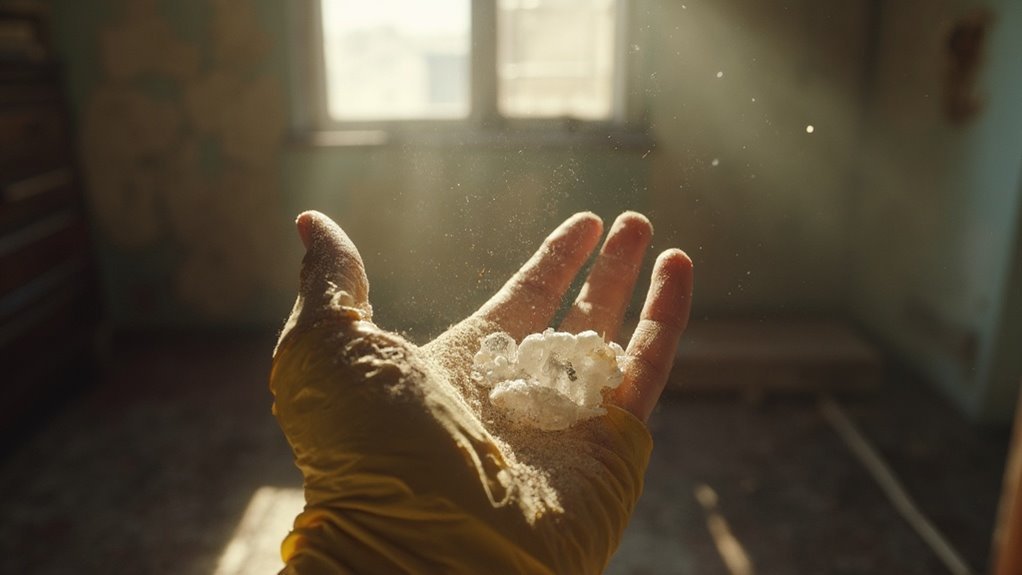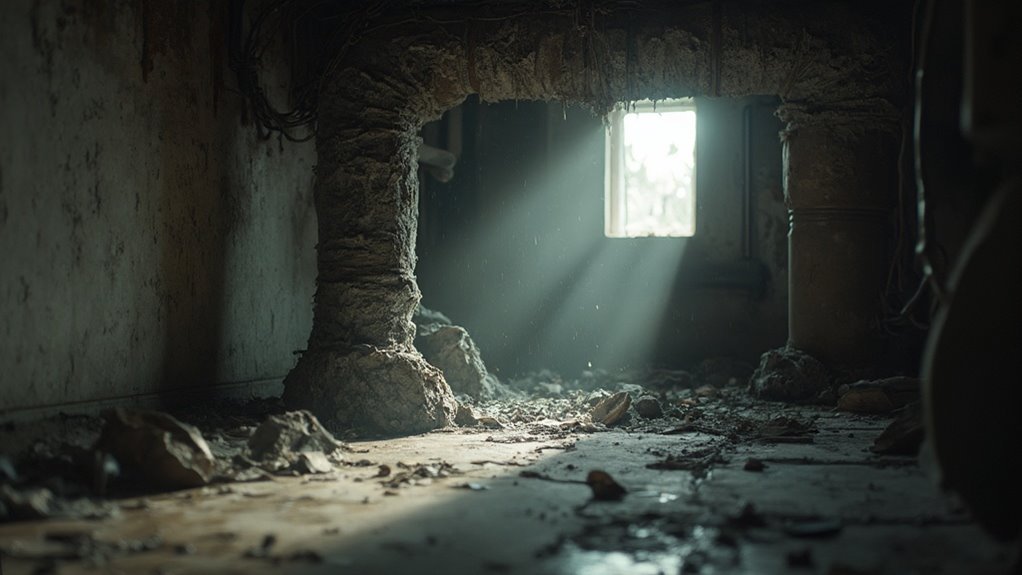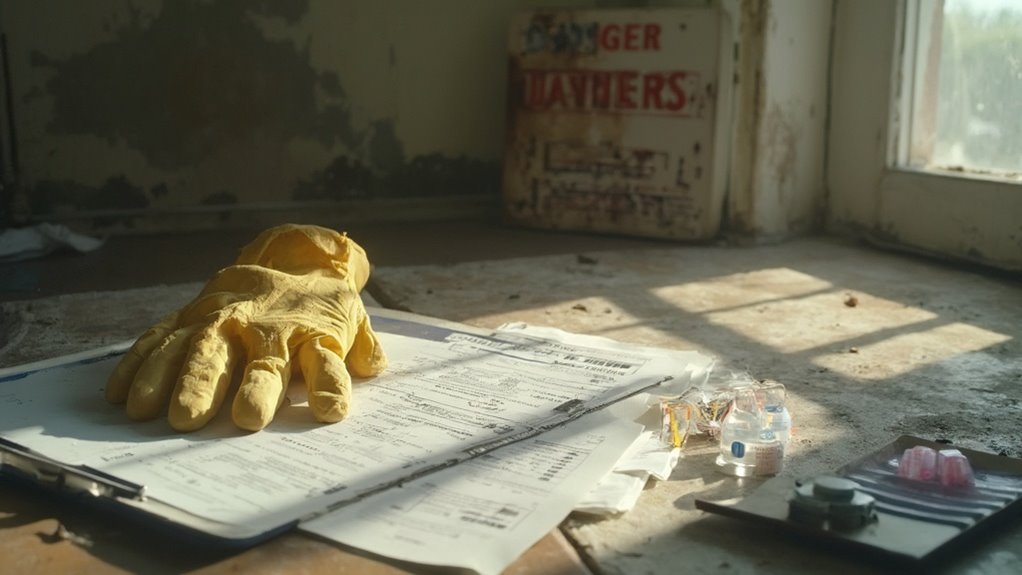If you're unaware of the critical role asbestos testing plays, you could be endangering your family's health. Asbestos fibers become airborne when disturbed, leading to serious diseases like lung cancer and asbestosis. Many common household materials, such as older insulation or textured paints, may contain asbestos. Without proper testing, you risk exposure during renovations or even day-to-day activities. The EPA emphasizes the need for professional assessments before any work begins. Understanding these factors is vital for safeguarding your loved ones. Uncovering more about the testing process and regulations could help protect your family from hidden dangers.
Understanding Asbestos Exposure

Asbestos, a fibrous mineral once valued for its durability and heat resistance, poses significant health risks when its fibers become airborne. Understanding asbestos exposure is imperative for ensuring fiber safety and complying with asbestos regulations. You can be exposed to asbestos through various methods, primarily inhalation of airborne fibers released from damaged asbestos-containing materials. These fibers can likewise enter drinking water from eroded natural deposits or contaminated pipes.
Naturally occurring asbestos can be found in soil, particularly in areas eroded from asbestos-bearing rock. You may unknowingly expose yourself and your family to asbestos through contaminated soil and dust. Furthermore, workplace exposure remains a significant risk, especially in construction and manufacturing sectors, where asbestos was widely used in products. Asbestos exposure can lead to fatal health complications and increase the risk of lung cancer. Inhalation of asbestos fibers can cause lung tissue damage, leading to serious diseases like asbestosis and mesothelioma.
It's critical to recognize that secondary exposure can occur when asbestos fibers are brought home on clothing. As a result, regular inspections of your living environment and proper containment during any removal or repair work are fundamental for maintaining fiber safety. Adhering to asbestos regulations and ensuring professional handling during abatement can protect your home and loved ones from potential exposure.
Health Risks of Asbestos
Exposure to asbestos fibers frequently leads to severe health consequences, manifesting primarily as lung cancer, asbestosis, and mesothelioma. These conditions arise from inhaling asbestos, with the risk increasing proportionally to the dose and duration of exposure. You should be aware that even small amounts of asbestos can result in mesothelioma, particularly in individuals with genetic vulnerabilities or pre-existing lung diseases.
The latency period for these diseases can span 20 to 50 years, meaning symptoms like coughing and shortness of breath might not appear until decades after exposure. Asbestos regulations emphasize the significance of recognizing these exposure symptoms early on.
It's essential to understand that certain types of asbestos, such as amphibole, may pose greater risks than chrysotile. Furthermore, if you or someone in your household works with asbestos, secondary exposure could similarly endanger your family's health. Regular inspections and professional handling of asbestos materials are important to mitigate these risks. By staying informed and vigilant about asbestos exposure and its potential health impacts, you can better protect yourself and your loved ones from its long-term dangers. Additionally, early detection through regular testing is critical for reducing health risks associated with asbestos exposure.
Common Sources in Homes

You might not realize that common household materials can contain asbestos, posing significant risks. For instance, vermiculite insulation, particularly from Libby, Montana, often harbors asbestos fibers that can become airborne during renovations. Furthermore, various products like textured paint and certain vinyl flooring can likewise be sources, making it essential to identify and manage these materials safely.
Vermiculite Insulation Risks
While many homeowners may appreciate the insulating properties of vermiculite, it's vital to understand the potential risks associated with this material, especially in homes constructed between 1920 and 1991. Vermiculite insulation often contains asbestos fibers, which pose serious health risks upon disturbance.
Here are some common sources of vermiculite insulation in homes:
- Found in attics and walls of homes built before 1991
- Primarily mined in Libby, Montana, leading to widespread use
- Resembles shiny, light brown or gray flakes or pebbles
- Usually assumed to contain asbestos if installed pre-1991
- Testing may not be necessary; professional assessment is advised
The main health concern arises when vermiculite insulation is disturbed, releasing airborne asbestos fibers. These fibers can lead to diseases such as asbestosis, lung cancer, and mesothelioma. If you have vermiculite insulation, it's safest to leave it undisturbed and to seal any cracks to prevent contamination. If removal is needed, always hire trained professionals to handle the process and minimize exposure. Understanding these risks can help you protect your family and guarantee a safer living environment.
Household Materials Containing Asbestos
Asbestos is often found in a variety of household materials, posing unseen risks to residents. Many common household products contain asbestos, especially in older homes. For instance, ceiling textures, tiles, and panels may have asbestos fibers, as could flooring materials like vinyl tiles and cement flooring. Insulation materials are another significant source, with asbestos commonly found in boiler, duct, and furnace insulation, in addition to loose fill insulation in attics.
Moreover, appliances may harbor asbestos in their insulation or heating elements, and electrical components may include cloth wire insulation and panel partitions. In decorative items, textured paints and certain art supplies might likewise contain asbestos.
The risk extends to various areas of your home, including attics, basements, and crawl spaces, where insulation and construction materials may be present. It's essential to identify these household products and materials to protect your family. If you suspect asbestos in your home, consider professional testing and removal to mitigate the risks associated with this hazardous substance. Understanding where asbestos can lurk helps you take proactive steps for safety and peace of mind.
Importance of Testing
Testing for asbestos is fundamental in safeguarding public health and preventing exposure risks. By conducting thorough asbestos identification, you not only protect yourself but likewise those around you. Understanding the importance of testing can lead to knowledgeable choices about managing asbestos in your environment.
Here are key reasons why testing is essential:
- Prevents asbestos exposure risks, safeguarding public health.
- Facilitates appropriate management and removal strategies.
- Significant before demolition or renovation of older buildings.
- Important for environmental monitoring and remediation efforts.
- Helps assess the extent of asbestos contamination.
These testing procedures, such as phase contrast polarized light microscopy (PLM) and transmission electron microscopy (TEM), are pivotal in accurately identifying asbestos fibers. Regular testing additionally allows for early detection of contamination, which is crucial for minimizing health risks like lung cancer and mesothelioma.
Ultimately, proactive asbestos testing not only guarantees safety during renovations or demolitions but also contributes to long-term public health efforts. By taking these necessary steps, you can effectively mitigate the risks associated with asbestos exposure, keeping your family and community safe.
Regulations and Guidelines

Understanding the regulations and guidelines surrounding asbestos testing is critical for anyone involved in renovation or demolition projects. The Environmental Protection Agency (EPA) mandates that asbestos testing must occur before any demolition or renovation activities, with specific exclusions for residential buildings with four or fewer units. A thorough inspection is required, covering all accessible and hidden areas where work will take place. It's pivotal to collect bulk samples from all suspect materials, as it can't be assumed they contain asbestos, and these samples must be analyzed by a certified laboratory.
Additionally, the Occupational Safety and Health Administration (OSHA) enforces exposure limits to protect workers, requiring that no employee be exposed to airborne asbestos concentrations exceeding 0.1 f/cc over an 8-hour shift. Employers must monitor operations for potential fiber generation and designate a competent person to identify and address hazards.
Proper record-keeping is fundamental, including detailed reports of inspections, sampling, and results, all certified by a professional. By adhering to these asbestos regulations and testing guidelines, you'll help guarantee a safer environment for everyone involved.
Professional Help for Safety
When dealing with asbestos, it's crucial to rely on certified asbestos professionals who have undergone rigorous training and accreditation. Safe removal practices are critical to preventing health risks associated with asbestos exposure, ensuring that the process minimizes fiber release. Engaging qualified experts not only complies with regulations but additionally safeguards your health and that of those around you.
Certified Asbestos Professionals
Certified asbestos professionals play a crucial role in managing the risks associated with asbestos exposure. Their expertise guarantees that asbestos-containing materials (ACMs) are handled safely, protecting both your family and the environment. These professionals must meet specific certification requirements to demonstrate their professional qualifications, which include:
- EPA Asbestos Abatement Worker Certification: Required training and examination.
- OSHA Asbestos Safety Certification: Guarantees compliance with workplace safety regulations.
- AHERA Certification: Vital for handling asbestos in schools and public buildings.
- Specialized Training Courses: Cover roles such as Inspector, Management Planner, and Project Designer.
- Knowledge of PPE: Certified professionals understand the proper use of personal protective equipment.
Safe Removal Practices
To guarantee safe asbestos removal, engaging professional help is essential. Trained experts utilize proven removal techniques and strict safety measures to protect you and your family from exposure. Before any removal begins, they seal off the area with polyethylene sheeting to contain any potential asbestos fibers. Engineered controls, such as negative air pressure units and HEPA filtration systems, help confirm that the fibers don't spread throughout your home.
Professionals implement wet removal techniques, dampening asbestos-containing materials to minimize airborne particles. Controlled dismantling and gentle handling of these materials further reduce the risk of fiber release. Once removed, they double-bag and securely seal the asbestos in heavy-duty plastic, clearly labeling the containers.
Safety measures extend to the workers, too. They wear personal protective equipment, undergo thorough training on procedures, and follow strict decontamination protocols. Air quality is monitored throughout the process, and air scrubbers and HEPA vacuums are used to maintain a clean environment. By relying on certified professionals, you guarantee that the asbestos removal is conducted safely and in compliance with all regulations, protecting your household from the dangers of asbestos exposure.
Frequently Asked Questions
How Can I Tell if My Home Has Asbestos?
To uncover hidden dangers, use a home inspection checklist focusing on materials likely containing asbestos. Employ professional asbestos identification methods, ensuring you safely assess your home's risk without exposing yourself to harmful fibers.
What Are the Costs Associated With Asbestos Testing?
Asbestos testing costs can vary widely based on factors like property size and sample type. Typically, expect home inspection expenses between $231 and $778, with professional services ensuring accurate, compliant results to safeguard your family.
How Long Does Asbestos Testing Take?
Asbestos testing duration often feels like a waiting game, but it typically takes one day to a week. Delays in sample collection or lab analysis can prolong your exposure to potential hazards.
Are DIY Asbestos Testing Kits Reliable?
DIY asbestos testing kits often struggle with accuracy because of their limitations, leading to potential misidentification. Without professional expertise, you might face false positives or negatives, jeopardizing your safety and that of your family.
What Should I Do if Asbestos Is Found in My Home?
If you find asbestos in your home, you should hire professional services for safe asbestos removal. They'll assess the situation, contain affected areas, and guarantee compliance with regulations to protect your health and safety.
